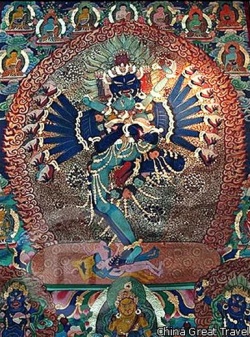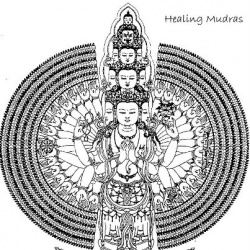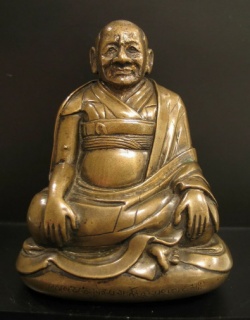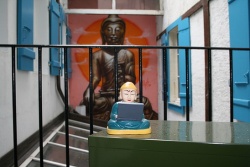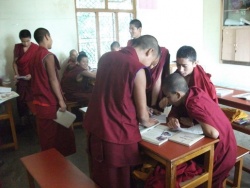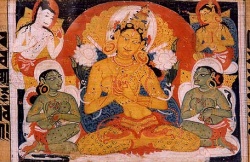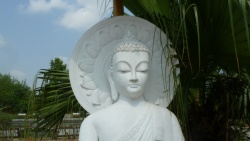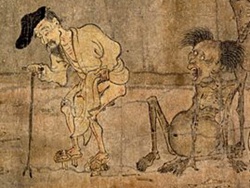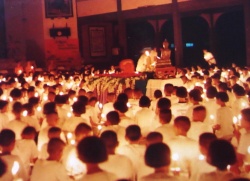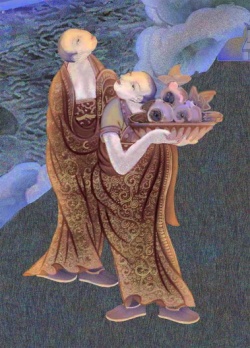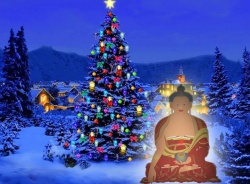A Buddhist Approach to Dreams
A Buddhist Approach to Dreams
Jung and Junti - Dreams West and East
by Rev. Heng Sure - http://paramita.typepad.com
In graduate school, I wanted to look deeper into my dreams so I joined a Jungian dream circle in Berkeley. A group of ten dreamers kept journals and told our dreams to each other. The group was moderated by a Jungian analyst who dispensed insightful guidelines for us to use on our own. The experience was moderately enlightening; my dreams became a wider door to enter and explore for self-knowledge. Later I was thrilled to discover discussion of dreams in the Buddhist texts I was translating. The excitement was initially short-lived, because the sutras said, “Dreams are false and illusory.” Trying to build a bridge the West to the East and merge Jung’s ideas with the Buddha’s approach to dreams was, no matter how unwise, nearly irresistible. Both Jung and the Buddha were consummate psychotherapists, both were compassionate and practical teachers of dreamers. The major difference seems to be that Jung lacked religious faith; he was bound by his senses and he saw dreams as a means of achieving peace and psychic wholeness in this life. Dreams for Jung opened a door into the individuated Self. For the Buddha, dreams opened a door into the ultimately empty and selfless nature of all dharmas. This emptying out of the self in turn made possible the liberating vision of Great Compassion, which sees all beings as sharing the same body and substance.
We know how the Buddha and certain Indian Buddhists in the past dealt with their dreams because detailed writings still exist in the scriptures and commentaries. This article will present a section from a particular Buddhist scripture, The Sutra on the Junti Bodhisattva Dharani, Spoken by the Mother of Seven Kotis of Buddhas (T.1077), which lists specific dream images. To put the Buddhist treatment in context, I will present dream categories from a Buddhist commentary, the Great Perfection of Wisdom Sutra, called the Ta Chih Tu Lun, (T. 1509) “The Great Wisdom That Crosses Over,” by Nagarjuna Bodhisattva (dates uncertain), and his Chinese translator, Venerable Kumarajiva (343-413 CE). Nagarjuna explains the Buddha’s wisdom-texts by drawing from an encyclopedic knowledge of the traditional lore of Indian culture, customs and literature. His presentation of dreams represents the available knowledge of third and fourth century India. After translating and investigating some of the methods that appear in the Junti Sutra and the Ta Chih Tu Lun, I will present some of the material the ancients passed down surrounding dreams and draw some conclusions. I will mention only in passing the ideas of Carl Jung regarding the value and the purpose of dream analysis. The exercise can make the dream-wisdom of the ancients relevant to us who seek to awaken today.
Part One: Two Methods of Dealing with Dreams
A. European Approach to Dreams
It is said that the Swiss psychologist Carl Jung in his lifetime analyzed over 80,000 dreams–. Dreams for Jung played an important complementary role in the psyche. The general function of a dream is to try to restore our psychological balance by producing material that reestablishes, in a subtle way, the total psychic equilibrium. Jung approached dreams as living realities that must be experienced and observed carefully to be understood. He considered Freud’s method of “free association” as incomplete. “Free association will bring out all your complexes, but hardly ever the meaning of a dream. To understand the dream’s meaning, I must stick as close as possible to the dream images.” During analysis, Jung kept asking the dreamer, “What does the dream say?”
One answer comes from Jeremy Taylor, a well-known authority on Jungian dream work who postulates five basic assumptions about dreams: 1) that all dreams come in the service of health and wholeness; 2) that no dream come simply to tell the dreamer what he or she already knows; 3) that only the dreamer can say with certainty what meanings a dream may hold; 4) that there is no such thing as a dream with only one meaning; and 5) that all dreams speak a universal language, a language of metaphor and symbol. The thrust of Taylor’s and Jung’s approach to dreams is individual-centered, a particularly Western concern. For serious-minded seekers of truth via dream-work the Jungian approach helps you puzzle out the integration of your individual psyche with the analyst as best you can, for a happier and more fulfilled life in this world. This goal is, nonetheless, far more sophisticated than the superficial “good and bad fortune” question that the great majority of people in the world ask their dreams.
B. An Indian Approach to Dreams
When Buddhists in India dreamed they dealt with their dreams in a variety of ways. Certain types of dreams occurred frequently enough to the ancients to merit listing as separate categories for dream-analysis. The categories show the following different kinds of dreams. The most distinctive use, for Buddhists, was
1) seeing dreams as a simile for emptiness, sunyata, the ultimate nature of all things.
2) seeing dreams as portents of things to come, which overlapped with another type of dream:
3) as messages or teaching by the gods, spirits or bodhisattva.
4) Buddhists in India and in China thought, like Freud and Jung, that it was possible to diagnose aspects of the dreamer’s mental and physical health from the symbols of dreams.
5) The theoretical psychology school of Buddhism, the Vijnanavada (“Consciousness-only”) school called dreams “monkey-sleep,” a function of the “isolated mind-consciousness”.
6) Buddhist psychologists saw dreams as the return at night of things thought on during the day.
7) Finally, Nagarjuna explained dreams as a standard for testing the quality of a bodhisattva’s vows.
Dreams appear in the earliest Buddhist writings, and played no less an important role in Buddhism than in our lives today. Being human, Buddhists have always slept; and when asleep, they dream. While dreaming they perceived the same disembodied shadows and disconnected images as we do. After waking they sought the meaning of their dreams. The diviners and prognosticators of India and China, being culture-bound individuals, interpreted the dreams according to the modes and methods available to them. Those methods were in some respects suggestive of methods used today, in some respects they were quite different. Dreams are very democratic; both rich and poor alike dream at night. But when trying to analyze what dreams meant, it is important to know who the dreamer was. The educated, literate, elite certainly had more options in their systems of dream analysis. Dreams could be messages from ancestors and Sages more often for a prince or a scholar because they had a concept of history. Uneducated individuals seemed to turn to formula-books of ready-made dream interpretations to explain the symbols of dreams. Generic do-it-yourself recipes, such as Aunt Sally’s Dream Book and Horoscope Love Advisor that we find at the supermarket check-out counter had its counterpart in most cultures. Dream interpretation formulas answer some superficial questions, to be sure, but they tend to center on love, money, and bad luck. Nagarjuna’s Ta Chih Tu Lun gives us the following important patterns that occur regularly in dreams:
1. Dreams as a simile for emptiness.
The most common use of dreams in the literature of the Mahayana, or “Northern School” of Buddhism in China, Tibet, Japan, Korea, and Vietnam is to see dreams as a simile for sunyata, (emptiness) the hollow core at the heart of all component dharmas (things). For example, in the well-known Vajra (Diamond) Sutra, the Buddha taught that:
“All conditioned dharmas, are like a dream, like an illusion, like a bubble, like a shadow, like a dewdrop, like a lightening flash; you should contemplate them thus.”
Dreams symbolize the changing and impermanent nature of all things known to the senses. Sights, sounds, smells, flavors, sensations of touch and thoughts are all dream-like, fleeting, and ultimately unobtainable. By pursuing and grasping material things or ephemeral states, we create the causes for misery and suffering. Those desire-objects are not real and permanent. When they break up and move on, we will experience grief, if we can’t let go. The hallmark of living beings is that we are “sleeping, “ unawakened to the truth of the emptiness and impermanence at the nature of conditioned things. This covering of sleep and lack of awareness is called “ignorance,” and it makes us in our waking state, from the Buddha’s viewpoint, look as if we are dreaming.
Bubbles burst, shadows run from light, dewdrops vanish by noon without a trace, lightning roars and vanishes, and dreams leave us at dawn. To continually perceive such things as real locks us into the endless cycle of birth and death. The Buddha was not simply giving us an evocative metaphor, a literary device or a philosophical point. He felt related to all beings, and in his compassion he was pointing out to his family a way to escape the prolonged misery of affliction and death. The dream simile occurs over and over in the sutras to teach about emptiness.
In the Ta Chih Tu Lun dreams occur as a didactic teaching device. Sariputra, the foremost Arhat in wisdom, learns the true application of the emptiness theory through the simile of dreams. Dreams are like ordinary waking reality in that both are empty and false. There is nothing gained by seeking out or clinging to any thought or mark that distinguishes the two states.
With the exception of message-dreams and portent dreams, two categories that we will look at below, for the Buddha’s monastic disciples who were intent on cultivating the mind full-time, dreams were considered as illusory and false, no different from the illusions of waking-time reality.
2. Message-dreams or teaching by the gods, spirits or Bodhisattvas;
Dreams can be a message from a Bodhisattva, an ancestor, or a god, The intent of the dream may be to test the dreamer’s resolve: is he non-retreating (avaivartika) from Bodhi (enlightenment) even when sleeping? The purpose of the dream visit may be to communicate information vital to the dreamer’s well-being. The Buddha himself had five dreams of catastrophes, falling stars and worlds in collision just before his enlightenment. The dreams were sent to him not by a benevolent Dharma-protector, but by an malevolent sorcerer, intent on disrupting the Buddha’s samadhi and preventing his awakening.
3. Prescient or Portent Dreams
Prescient or portent dreams that predict the future are the only category of dreams that the ancients considered real or valuable in itself. Based on the records we have, it seems that dreamers in the past wanted to know more or less what dreamers want to know now: whether their dream augured good luck or misfortune. The office of dream diviner was esteemed, and nobility and commoner alike, waking after a dreamy sleep, sought to know the meaning of their dreams.
4. Aspects of the dreamer’s physical and mental health
Although according to the sutras, dreams were considered ultimately false, Indian Buddhists also used dreams as an aid to diagnosing the dreamer’s state of health. According to ancient Indian Ayurvedic medical systems, dreams of fire indicate an imbalance of the fire element, dreams of flying indicate an excess of water, etc. This methods of diagnosis suggest similarities with Chinese dream interpretation systems found in one of the earliest Chinese medical texts, the Yellow Emperor’s Classic of Internal Medicine. (Huang Ti Nei Ching Su Wen). The symbols of the dream have value as indicators of health or illness.
5. “Monkey-sleep,” a function of the isolated consciousness;”
The Consciousness-only School (Vijnanavada) looked into the nature of mental phenomena. That school assigned the function of dreams to a part of the mind they called the “solitary intellectual consciousness.” Dreams share that classification with insanity, twilight sleep, “monkey-sleep” the marginal consciousness of drowsiness, and the mind in samadhi.
6. The return in dreams of things experienced during the day
Dreams were understood from a psychological perspective, as a replaying of the contents of consciousness. What the dreamer experienced during the day could return at night as a dream image. Dreams, although considered as empty and false can still produce a physical reaction, as when a dream-vision of a romantic encounter can produce a wet-dream in sleep.
7. A standard for testing the quality of a cultivator’s vows
Dream visions of suffering, such as the sight of beings in the hells will move a true Bodhisattva to make compassionate vows to rescue those beings. Great Bodhisattvas would sometimes send dreams on purpose to novice Bodhisattvas, to stimulate them to make the great Bodhi Resolve. If a Bodhisattva cultivates compassion in a dream, then the dream vision of rescuing from suffering may return to him when he/she is awake. The dream reminds the Bodhisattva of his ability to endure suffering on behalf of others. Since dreams and waking are thought to be the same, then the Bodhisattva gets inspired to repeat his dream-performance during the day. In light of the Perfection of Wisdom, the theory of emptiness is merely a raft, an expedient device to help us ford the river of suffering ourselves and to then to help others attain bliss.
Dream interpretation as an index to the integration of one’s character, dreams as clues to mental health, or as the high road to self-understanding was not unknown, but seems to have been, as it is today, an answer to a question that relatively few people were asking.
The category of dreams as a test of the dreamer’s good roots is evidenced by the Junti Bodhisattva’s Sutra. Now we will look at a selection from the sutra that deals with dreams.
Part Two: A Section From the Junti Bodhisattva Sutra on Dreams
The Junti Dharani Sutra, Spoken by the Mother of Seven Kotis of Buddhas Thus I have heard, at one time, at one time, the Bhagavan was in the city of Sravasti, In the Jeta Grove, in the Garden of the Orphans and the Solitary, together with a great gathering of Bhikshus, and Bodhisattvas, as well as the gods, dragons, and the Eight-fold Pantheon, who encircled him on all sides. Out of sympathy and pity for living beings of future times, who will be poor in blessings and full of bad karma, he entered into the Junti Samadhi and spoke a mantra that came from the mother of seven ages of Buddhas of the past. The mantra runs like this:
Na Mwo, Sa Dwo Nan, San Myau San Pu Two, Jyu Jr Nan, Da Jr Two, Nan, Je Li Ju Li Jun Ti, Swo Pe He.
If there are Bodhisattvas among the clergy or the laity who commit the heaviest of offenses for limitless eons, even be it the Ten Evil Deeds, the Four Unpardonable Offense, the Five Cardinal Sins, and offenses that merit retributions, if they cultivate the practice of reciting and holding mantras, and can recite this mantra fully 900,000 times, all such offenses will be wiped away. Wherever they live, they will meet the Buddhas and Bodhisattvas, they will enjoy abundant wealth, and will meet many opportunities to leave the home life and enter the Sangha.
If they are Bodhisattva’s practicing at home, and their cultivation of the moral precepts is firm and non-retreating, should they recite this Dharani, they will always be reborn in the heavens. If they appear in the human realm they will always be part of the kings clan. They will avoid falling into the evil destinies and will get to draw near worthy sages. They will be revered and respected by the Devas, who will protect them and bless them. If they get involved with worldly matters, they will not encounter disasters. Their appearance will be proper and handsome, their voice majestic and calming. Their mind will be free of worry.
If the person is a Bodhisattva among the Sangha, they will be replete with pure precepts. They will recite sutras in the three periods of the day and they will practice the Dharma as it is taught. The Siddhis (states) that they seek in this life will appear before them in samadhi and wisdom. They will realize the (Ten) Stages and the (Six) Paramitas will be complete. they will certify straight-away to Unsurpassed, Right and Equal Bodhi.
If they recite this mantra ten thousand times, then in their dreams they will see the Buddhas and Bodhisattvas, and they will dream that they spit out a black substance. Even if the dreamer has committed serious karmic offenses, and they can recite the mantra twenty thousand times, they will see the heavens and the celestial monasteries and halls, or perhaps they will see themselves climbing a tall mountain, or climbing a tree; or see themselves bathing in a large pool; or see themselves soaring aloft; or playing together with maidens from the heavens; or see themselves speaking Dharma, or shaving away hair and beard, or eating “milk-rice”; or see themselves drinking white sweet dew. They may in a dream see themselves crossing a great ocean or river or stream; or ascending a lion’s-throne; they may see a Bodhi-tree; or see themselves riding a boat.
They may see a Shramana, or a layman, or a white-robed person wearing a yellow turban. Or maybe they will see the sun and moon, or virgin lads and maiden girls, or see a ripe fruit tree over head. They may see a black-hued hero whose mouth spits out flames and smoke, and in a struggle with him, they emerge victorious. He may see an evil-tempered horse or cow, that wants to gore him. The mantra recitor, whether he hits or scolds, will cause the animal to run in fear. Or he may see himself eating milk-porridge or butter-porridge, or he may see Sumana Flowers, or a vision of a king. If someone fails to dream of visions such as these, you should know that this person in a past life committed the five cardinal sins. He then should recite anew, 700,000 times and then these visions will occur to him. Then he can be assured that his karma has been dispelled. Once the karma is over, he will accomplish the former practices. If he then paints an image according to the Dharma, and as is appropriate to the Dharma, makes offerings to it either three times or four times or six times, seeking mundane or world-transcending siddhis, up to and including Unsurpassed Bodhi, all such wishes will be completely fulfilled.
A) Discussion of The Junti Sutra
The Junti Sutra is based on a Bodhisattva’s vows. The purpose of the Sutra is to provide an expedient method to erase evil karma and to create good roots. Junti is a powerful, compassionate Bodhisattva who lives in the heavens and is known primarily by the mantra that is associated with his/her name. Like Bodhisattva Guan Yin (Japan: Kannon, or Tibet: Chen Re Zi), Junti Bodhisattva’s iconography shows many hands and eyes, each one holding a tool for crossing over the afflictions of living beings. Like Gwan Shr Yin, Junti’s image transcends gender. Neither male or female, Junti blends both compassion and courage. Junti is called the “mother of seven kotis (myriads) of Buddhas.” In many respects Junti’s practice seems to belong to the esoteric, Vajrayana school, in fact her great compassion makes her a favorite of the Mahayana School as well. Junti explains dreams, and Buddhists turn to her to find out what last nights reverie meant.
Junti explains dreams in connection with a mantra that is associated with her Dharma-door. Mantras are sounds of power, seed-syllables spoken in Buddha-language. When you recite any of the syllables , for instance, Om (Chinese. “nan”) or Namah (Chinese. “namo”) the sound acts like a password, like a command, to grant any positive wish. The spiritual beings associated with that syllable act on your behalf to do your bidding. Mantra-sounds were said by the ancients to have the power to create or destroy. There are certainly positive, “white magic” mantras, as well as not so wholesome, “black magic” spells. Junti Bodhisattva’s mantra is decidedly wholesome and positive. When one recites her mantra, If the reciter’s mind is pure and unselfish, Junti guarantees that the desired results will come to pass.
The sutra exists because the Buddha Shakyamuni knew about the vows made by Junti Bodhisattva. Out of compassion, the Buddha spoke the mantra. He knew that living beings in the future (i.e., us, now) will have spent our bank account of blessings and will pile up bad karma. By judicious and vigorous use of the mantra’s power we can reshape our karmic balance, reverse the debit of evil retribution, and engineer a future of blessings, wisdom, and happiness.
The connection with dreams occurs with the teaching that whoever recites the mantra the right number of times will be able to eradicate bad karma. The sutra gives us dream symbols that will be seen by one who recites Junti Bodhisattva’s mantra. Heavy, bad karma can obstruct a person and prevent the vision of the dreams. Once the person cultivates the mantra and neutralizes the bad karma, the dream symbols should appear.
We need to recite or “hold” the mantra over and over from Na Mwo to Swo He. Junti’s mantra is to be recited while visualizing its Sanskrit letters revolving on a two-sided metal mirror. One side is Sanskrit devanagari writing, the other side is Chinese characters that represent the sounds.
Dreams are the sign that indicates the invisible balance of good and evil on our karma-ledger. The dreams symbols that the Buddha lists include visions of purging, bathing, good companions, transformation from defilement to purity, passage over boundaries, ascending in space and climbing mountains. One sees the eating of pure foods, healing, auspicious visions of nature, escape from danger, and scenes of beauty. The feelings that accompany the dreams will be completely soothing, there will be a sense of blissful relief, free of anxiety, alarm and doubts.
Among the types of dreams that we found listed in the Ta Chih Tu Lun, the series of dream images that appear in the Junti Sutra clearly belong to the category of dreams that index good roots, and show the dreamer’s state of cultivation. By using the Dharma-door of the mantra, one puts the beneficial and pure sound of the mantra in one’s mouth and ear; one visualizes the symbols of the letters in one’s eye. One brings the compassionate energy of the Bodhisattva into one’s mind and plants the ancient seed-sounds in the eighth consciousness. The power of the mantra neutralizes evil, transforms it to good and brings about healing in the mind, which is the source of good and bad karma. This is a transcendent use of dreams. Dreams become an expedient means to aid one’s spiritual progress towards Buddhahood, and ultimate liberation.
B) A Comparison of Western and Eastern Methods
Carl Jung believed that because the dream deals with symbols that have more than one meaning, there can be no simple, mechanical system for dream interpretation. All attempts at dream analysis must take into account the attitudes, experiences and background of the dreamer. It is a joint venture between dreamer and analyst. The dreamer interprets the dream with the help and guidance of the analyst. The analyst may be vitally helpful, but in the end only the dreamer can know what the dream means. We may wind up frustrated if we expect the Buddhist's use of dreams in the Junti Bodhisattva Sutra to reflect a Jungian approach.
I present the sutra in the context of a Buddhist method that was in vogue seven centuries after the Buddha spoke the sutra. This method is closer in time to his culture and steeped in the culture of monastic cultivation, but not given only to the monk or nun. The challenge to contemporary analysis is to search out the kind of questions a Buddhist might ask of these dreams.
If the list of images from the Junti Bodhisattva Sutra were to appear to a dreamer in analysis with Jung or Taylor, the Western analysts would likely investigate the meaning of each symbol with the dreamer. They would attempt to map out the shadow, the anima/animus, the self and the various archetypes of the unconscious as they emerge over a lengthy series of encounters. Ultimately, like Jung himself, at life’s end one may have a highly auspicious dream that augurs an individuated character and a rebirth in the desired heaven.
I find the Buddhist use of dreams profound and broad in scope. No matter how well we intellectually grasp the patterns and the symbols of the unconscious, if our karma is still as heavy as before we began to discuss the dream, then no matter how thoroughly we penetrate the dream-symbols, we will still be turning on the wheel of rebirth, bound to endless rounds of suffering. Buddhist dream analysis says that the images of dreams themselves are empty and false; but properly understood, they can serve as another door to liberation.
The Sutra includes a fail-safe; if one follows the Buddha’s formula and does the right number of recitations, and it doesn’t seem to work; i.e., the dreams don’t come, then the Buddha gives a power-booster. Paint or draw an image of Junti Bodhisattva (I will leave it to the reader to judge whether pixel-based computer-drawn or painted images qualify) and then make offerings to the image (virtual offerings probably show less sincerity) three, four, or six times a day of pure vegetarian food (pure means no killing involved) and along with the requisite recitations. Then for certain all the good results that one seeks, up to the realization of Buddha-hood will come to pass.
C) Conclusion
Following a Buddhist example, how are we supposed to deal with dreams? Do we dismiss them as empty and false, do we diagnose our health from dream symptoms, do we systematically analyze their symbols as an index of our religious practice? Dreams used as a teaching device pointing the way to enlightenment takes a negative approach to a positive goal. The emptying out of both dreams and reality frees the mind from duality and attachments to conditioned states. Perhaps the Buddhist approach to dreams is identical with the path to understanding the purpose of waking life: transforming ignorance by the brilliant sword of Prajna wisdom. We must wake up from our “dream within a dream,” before we can know that we are actually sleeping through our lives. After awakening there is no need to dream any longer.
Bibliography
- Marie Louise von Franz, Dreams. Boston, Shambala, 1969.
- Jeremy Taylor, Where People Fly and Water Runs Uphill: Using dreams to Tap the Wisdom of the Unconscious, New York: Warner Books, 1992.
- http://www.worldtrans.org/CyberSangha/Suresm96.htm
